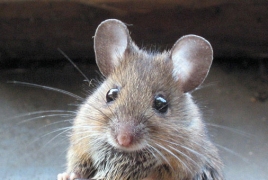U.S. scientists activate predatory behavior in mice January 13, 2017 - 14:10 AMT PanARMENIAN.Net - U.S. scientists have ramped up predatory behavior in mice by stimulating a region of the brain known for its role in emotions like fear and pleasure, AFP cited a study published Thursday, January 12 as saying. The experiment turned the lab mice into super-eating machines, vigorously attacking food, bottle caps, and sticks as prey, said the findings in the journal Cell. However, scientists cautioned that their goal was not to create an army of killer mice. Rather, it was to better understand how the brain works and perhaps one day improve the treatment of degenerative brain diseases that affect motion and coordination. "A major issue for neuroscientists is how the brain figures out how to respond appropriately to objects in the world," lead author Ivan de Araujo, associate professor of psychiatry at the Yale University School of Medicine, told AFP. "Predatory behavior is the perfect model. It is a great window into how the brain solves the problem of how we respond to external stimuli by moving our bodies in an appropriate way." Mice are omnivores, and will eat fruit, vegetables, insects and meat. They are natural hunters, even though they are more often thought of as prey for larger creatures like snakes, hawks and cats. Researchers decided to see how mice's behavior would change if certain neurons were stimulated using a process called optogenetics, which is also being experimented with to restore muscle movement in people who have been paralyzed, and to treat those with epilepsy or Parkinson's disease. Using an implantable brain device and a laser to activate certain neurons in the part of the brain known as the amygdala, researchers found two different pathways to changing a lab mouse's behavior -- one that triggered the animal's pursuit of prey, and another that signaled it to bite and kill. "We could make them more efficient hunters in the sense that they would spend less time to be able to capture live prey and subdue it and kill it," said Araujo. "Perhaps more strikingly, when we used a bug made of plastic that was moving around the cage, we could make the animals pursue an object that they would normally avoid," he added. "We triggered the behavior toward objects that were not live prey." The amygdala is an almond-sized region of the temporal lobe known for its role in emotions like fear and pleasure, as well as motivation and survival instincts. Authorities said a total of 192 Azerbaijani troops were killed and 511 were wounded during Azerbaijan’s offensive. In 2023, the Azerbaijani government will increase the country’s defense budget by more than 1.1 billion manats ($650 million). The bill, published on Monday, is designed to "eliminate the shortcomings of an unreasonably broad interpretation of the key concept of "compatriot". The earthquake caused a temporary blackout, damaged many buildings and closed a number of rural roads. Partner news |